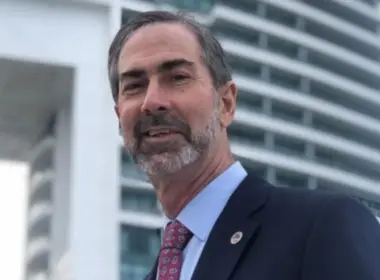The key for Interport is flexibility, knowledge – and owning nothing
By Katelin Stecz
Walking into the warehouses at Interport Logistics’ headquarters just west of Miami International Airport is like stepping into a giant beehive. Industrial storage racks stretch up to the 36-foot ceilings like massive slats of honeycomb. But instead of storing honey, they house air conditioning units, pallets of whiskey, and cotton t-shirts. Orange forklifts load and unload pallet after pallet to be tagged and processed. Lines of semi-trucks wait in holding docks, delivering or picking up from 82 bay doors; employees buzz around, completing each task with alacrity.
“Yes, it is like a beehive,” says Gary Goldfarb, Interport’s Chief Strategy Officer. “But,” he emphasizes, “there is no queen bee.” It’s a surprising statement from someone of such status in the company.

As Interport’s chief strategy officer, Goldfarb is responsible for taking the logistics giant into the future. Since he started working with the company in 2014, Interport has grown from about 40 employees to more than 100 at their Miami headquarters and about 400 within the entire Interport Group of Companies. Interport currently has around 850 active accounts and occupies a total of 400,000-square-feet around the country, 300,000 in Miami and most of the rest in Los Angeles. Its Miami warehouses load a collective average of 42 shipping containers worth of goods every day.
The warehouse operations, however, are just the tip of the proverbial iceberg. While Interport’s warehouses sort, store, and deliver a blistering catalog of goods – perfumes, clothing, hardware, tools, household appliances, shoes, lighting, consumer goods – that represents only about 25 percent of the company’s business as a provider of supply chain solutions. All of the remainder is based on using the most efficient delivery systems available, with personnel operating from eight regional offices outside the U.S. and an IT office in Costa Rica.
“If you really look at us, we are in the information business,” says Goldfarb. “We are a non-asset-driven logistics provider. Basically, we do not own trucks, containers, ships, or airlines. We rent the warehouses. We don’t want to be stuck with a given rail line. We need to deliver from anywhere in the world to anywhere else in the world as efficiently as possible, so we refuse to have any assets.” That way, says Goldfarb, Interport will always choose the best delivery solution for a given company, from steamship lines to air cargo carriers, rather than one which uses its own transportation alternative.
“We always have to be able to make the best decision for the customer,” Goldfarb explains. “We don’t own anything. Instead, we organize the movement of [products] and provide the information to the customer on a real-time basis… I am like a travel agent for cargo.” More than one-third of Interport’s business never even touches the U.S.; their ROW (of “Rest of World”) team organizes shipments from Switzerland to Brazil, for example, or from Asia to Central America, or from France to Asia. The remainder moves from foreign sources to the U.S., or from the U.S. to foreign destinations.
Goldfarb, who has worked in global trade and supply chain management for the last 50 years, has been integral to the development not just of Interport, but of South Florida’s entire trade scene. He has helped expand Miami’s Foreign Trade Zones (FTZ), established the Marine Industries FTZ in Fort Lauderdale, and developed game-changing software for the industry. Goldfarb has also helped create programs at both Florida International University and Miami-Dade College for supply chain management and logistics. Among many other achievements, he currently sits on the board of Miami-Dade’s economic development Beacon Council (where he was past chair) and is Vice Chairman of the World Trade Center Miami.
While Goldfarb has served as the high-profile rainmaker for the company, bringing in new clients, he is quick to defer to colleagues for the operational success of the company. Key among them is Jose De Vivero, CEO of Interport, who has been with the company since its inception. Before starting Interport in 2002, De Vivero worked with Goldfarb at the Golden Eagle Group, and in 2014, Goldfarb joined the Interport team as the Chief Strategy Officer.
As one of the founders, De Vivero has been integral to the growth of the company; besides running day-to-day operations, he’s been responsible for keeping Interport up to date with technological innovations. “Technology has been a huge part of our growth over the years,” says De Vivero. “Every six months, we kind of step back and evaluate the technology that we’re using because it changes so fast. We’re always looking into new things that we can adapt to be more efficient and provide a better service to the customer.”
One example is the company’s use of RFID, or radio frequency identification technology, for processing and tracking all the goods Interport receives. When a new shipment arrives at the warehouse, employees tag the boxes with an RFID tag and activate it with an RFID reader. Once the tag is activated, it works like a barcode, but instead of using a laser to read the code, the RFID system uses radio waves. This allows a radio frequency reader to identify a product anywhere in the warehouse – or even inside a shipping container – without having to unpack and scan each item.
“Before we started using these, we would have to shut down for two weeks to do inventory and count every single item. But now, we can have inventory done in six to eight hours,” says Goldfarb. For the tall stacks of goods in the warehouse, Interport uses a drone to float up and down the shelves, taking inventory as it goes.
Alex Guzman, Interport’s customer service manager, echoes Goldfarb. “With a drone, you can take an aisle, read it with RFID tags, and do a complete 100 percent accurate inventory in [a short] time,” says Guzman. “If a customer wants to know where something is, we can give them the information from the drone even faster.”

Interport also uses customized software to track everything, with all goods scanned from the moment they enter the Interport system. Their “track-and-trace” program provides customers with real-time information about their supply chains, even providing key performance indicators so they can see at which points their supply chain is slow or lacking. “Everything is one single system, so the customer can follow it electronically,” Goldfarb says.
Interport’s tracking system, right down to individual items, also allows the firm to act as a fulfillment house. For one customer, they ship thousands of individual packages to consumers in Brazil, for example; for another, thousands of packages every night to the Dominican Republic. “Every day, we go out with several thousand packages that are delivered to people’s doors,” Goldfarb says. “We bring it in by mass, and then one goes out per household, to, say 2,000 households. We’re like a fulfillment center, but we don’t take the orders.”
In some cases, Interport becomes not just a weigh station for the client, but their entire storage and supply backbone. One customer who manufactures air conditioning units in Japan had been shipping the units directly. Now, millions of dollars’ worth of inventory are stored at Interport’s U.S. warehouses for shipping on demand. “We created a system where they process the order, then we pick and send with an OK from Japan,” Goldfarb says.
The same thing happened with a brake pad manufacturer in Taiwan. “They had their own warehouse, doing all their own picking and packing. One day they had a problem with incorrect labels and couldn’t ship them. They said, ‘This is crazy.’ So, they gave up their warehouse and do everything with us now,” says Goldfarb. Adds De Vivero, “With our customers, we want them to see us as a company that’s not a service provider but part of their organization. We’re here to make them better. We’re here to make them grow.”
Another technology that gives Interport an edge is their cold storage capabilities, which plays off Miami International Airport’s designation as the first U.S. airport (now there are more) capable of moving products in a temperature-controlled environment throughout the shipping process. “We can handle anything from -18 degrees to 55 degrees Fahrenheit, whether it’s cheese or meat or medicine. We create special cold boxes, whatever is necessary,” says Goldfarb.
That mentality – “whatever is necessary” – runs through Interport’s corporate culture. Their commitment to customer service often works to their advantage for reasons besides the obvious. In tackling one customer’s specific problems, Interport usually finds an inventive solution that works for other customers as well. “With one customer, we had to create a whole new track-and-trace portal that we actually developed in-house, and it worked really well. So, then we started to provide that service to all our customers,” says Guzman.
Interport also maintains a corporate culture that encourages the educational and technical advancement of employees. According to Goldfarb, Interport tries to recognize and support its employees who demonstrate drive and willingness to learn within the company. That means paying for employees’ continued education.
As Goldfarb strides down a corridor containing ladders, tools, and PVC pipe, he recounts the story of one Interport employee who started out working in inventory. He showed aptitude in technology and is now involved with Interport’s RFID and about to pursue his master’s degree. When Goldfarb reaches the end of his story, he stops and surveys some of the employees who are scanning new products. “If you’re willing to learn, we’re willing to help you learn,” he says.
When Guzman started working for Interport, for example, he was in a basic warehouse data entry position. Within seven months, he was promoted to assistant warehouse manager. A few years later, he moved into customer service, and has now been Interport’s customer service manager for the last five years and is directly involved in some of Interport’s technological innovations.
Goldfarb, for his part, continues to ply the trade network of greater Miami, with strong personal relationships with everyone from members of the Consular Corps and the Beacon Council to Miami-Dade’s Mayor Levine-Cava (the county controls the sea and airports) and the World Trade Center Miami (WTCM).
“Gary is one of the real movers in the trade community,” says Ivan Barrios, CEO of the WTCM. “He’s been instrumental in getting things done that benefits trade to and from the area, and in bringing in new companies to operate from here.” Goldfarb was involved in the creation of Foreign Trade Zones in Miami, which allow for goods to arrive in bulk and then be sorted or assembled and reshipped tax and tariff-free. The Interport warehouses themselves, for example, act as Foreign Trade Zones.
“My job is to create something new, and bring in new accounts,” says Goldfarb. “A lot of my time is devoted to public organizations. I spend maybe five percent of my time in the warehouse. Once it’s in the house and operating, I’m out. It runs smoothly because the CEO runs it smoothly.”











